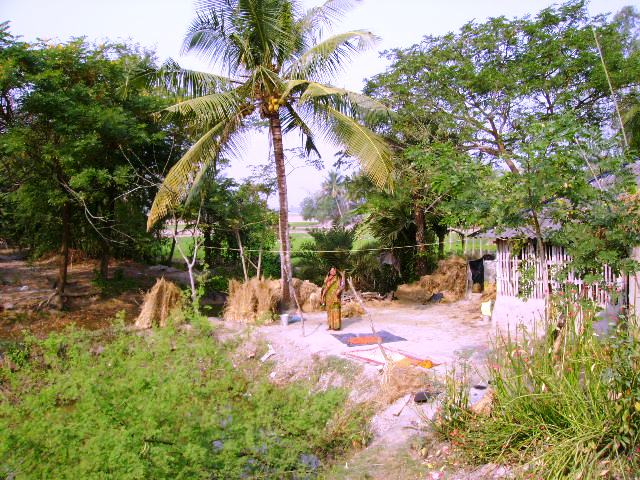We, a group of six soon-to-be senior citizens, travelled to the Sundarbans some years back. It has been one of our most cherished trips to a natural reserve that falls partly in India, and partly in Bangladesh. A luxury car arrived early in the morning to pick us up from our doorstep and take us to the Gadkhali Ferry Ghat in Basanti Island, a four-hour drive along rough roads and heavy traffic. We boarded a motorised boat named Baba Nobin, christened after the father of the captain who owned the boat. We sucked in the cool, salty breeze, free of the polluted air from car and bus exhausts on busy Kolkata roads. We were served a very tasty, hot, Bengali lunch of chicken curry and rice cooked in the lower deck of the boat, while we sailed across, drinking in the beauty of the islands around us, trying to catch a glimpse of a crocodile on the banks, or a water monitor, or a little doe playing hide-and-seek behind the trees in the forests beyond. We saw dolphins and baby sharks jump up and down the river waters and even the pug-marks of a tiger that might have come to the banks to drink water the night before, but no tiger. We “took time to turn at Beauty’s glance, and watch her feet, how they can dance”, courtesy William Henry Davies.
Prowling the delta
We had booked three cottages at the Sundarbans Tiger Reserve and Sundarban Jungle Camp in Bali Village. The cottages, each named after a mangrove tree, were designed to match the huts in the village though the interiors were equipped with modern facilities. No radio, no tape recorder, DVD player or television were permitted in the Sundarbans for fear of disturbing the animals. You will most often, not find a signal on your cell, nor can you approach a phone booth because there are none. There is no ATM booth except in the nearest island towns of Basanti and Gosaba. Placed in a different world, you do not miss these everyday mandates in the lap of nature. No one is permitted to sail before dawn and after sundown because the Royal Bengal Tiger might be on the prowl and attack as a defence strategy and not, as is popularly believed, to kill. Groups of deer are released in the core areas for the tigers as feed. The tigers swim across the sea when humans are not around. The Sundarbans are also famous for many amphibian animals, reptiles and mammals besides boasting a bird population spanning 180 bird species.

The Sundarbans is home to one of India’s most iconic wildlife species – the Royal Bengal Tiger. A tiger census is carried out from time to time and at last count, it was around 250. Among the endangered species are the tiger, the estuarine crocodile, river terrapin, Olive Ridley turtle, the Gangetic dolphin, the ground turtle, the Hawks Bill Turtle, and king crabs.
Formed by the confluence of the mighty rivers – the Ganges, the Brahmaputra and the Meghna – the Sunderbans are a part of the world’s largest delta situated on the lower end of the Gangetic West Bengal. It is also the world’s largest estuarine forest criss-crossed by hundreds of creeks and tributaries, intersected by a network of tidal waterways, small islands of salt-tolerant mangrove forests and mudflats. The interconnected network of waterways makes almost every nook and corner of the forest accessible by boats or rafts, making it one of the most attractive and alluring places on earth, and an undiscovered paradise. The islands are also home to 64 plant species that are acclimatised over time, climate and the environment to withstand estuarine conditions and saline inundation resulting from tidal effects. Whichever way you throw your glance from the sailing boat, you can see the mangroves kissing the sky, feel the peaceful waters without realising the dangers they might bring to the villagers at night by washing the villages away.
We were not scared of the tiger because the villagers who work in the resort as cooks, bearers, washermen, and housekeeping staff, kept our fears at bay by putting on a real jatra performance on the legend of the Bono Bibi – the Goddess of the forests they worship as a family deity who they believe, takes care of them and protects them from wild animals. Bono Bibi is a secular Goddess who keeps the Hindus and Muslims in harmony. “We are united by our devotion to Bono Bibi, by our fear of tiger attacks, and the fear of losing our homes any minute, any second through the erosion of the banks all the time,” says Alipada, one of the four brothers who works at the camp, while two of his brothers run the two steamers named after their parents.

Sundarbans is named after the Sundari trees that grow in large numbers filling the landscape and the riverscape. It is the largest single block of tidal halophytic mangrove forest in the world. It is a UNESCO World Heritage Site, and is marked as a Biosphere Reserve. The Sundarban forests span around 10,000 sq.km, of which a major portion is in Bangladesh, while the Indian portion is estimated at around 4,264 square km.
The tiger is not the danger here
“The biggest fear we live in is about the entire village getting sucked into the waters of the sea because the shores are breaking all the time. It is not the tiger we fear, but the tides that spell death everyday,” says Alipada. The southernmost inhabited islands that form the active delta change shape almost every day, no thanks to the most unpredictable changes in the river channels. Add to this the tidal waves that keep eroding the land from one side and build sandbanks everywhere. River belts swell because of heavy deposits of silt. According to a study by the Jadavpur University, the sea levels in the Bay of Bengal are rising at the rate of 3.4 millimetres per annum due to global warming. Two islands have been completely washed away into the sea, and a third, named Ghoramara, is sinking too. The island dwellers suffer from stress, insomnia, and other chronic mental ailments resulting from this fear.
Apurba Chakraborty, our naturalist and bird-watcher guide, escorted us to some of the important reserve spots at different points of the group of islands. Notable among them are Sajnekhali Watch Tower, Sudhanyakhali Watch Tower, a watch tower at Dobanki, Netidhopani, Burirdabri, Kumarmari and Jhingakhali. The watch tower at Sajnekhali has collapsed and has not been reconstructed yet. But there is a mangrove interpretation center that throws up a world of information on flora, fauna and the village life at the Sundarbans. At Sudhanyakhali, we climbed atop the watch tower, but could only glimpse a couple of deer and some wild boar in the distance, and our cameras clicked in chorus. Time did not permit us to visit Buridhabri, Kumarmari and Jhingakhali. The reserve camps were very clean without any food stalls or cold drink outlets. The Sundarbans is a ‘no-plastic’ zone, yet one can spot plastic bags floating across the waters cast away by unthinking tourists.
Of the 102 islands that make up Sundarbans on the Indian side, since 60 percent now lies in Bangladesh, only 54 are inhabited by some five million people, of whom around two million live in the active delta. The local villagers are honest, simple and straightforward. They are fisher folk, farmers, honey collectors, boatmen and frail women, who catch prawn seeds in waist-deep waters, ignoring the danger from crocodiles, sharks and the occasional tiger.
Climate
October to February — winter, cold and temperate
March to May — summer, hot and humid
June to September — the monsoon season, wet and windy
Monsoon cruises are spectacular.
How to Reach Sundarbans
Air:
The nearest airport is the Netaji Subhash Chandra Bose Airport at Kolkata (112 kms). It takes around three hours of road journey and two hours of boat ride to reach Sundarbans,
Rail:
Local trains to Canning are available from Sealdah (South) at regular intervals and takes about one and half hours. Local shared vans are available from Canning to Godhkhali Jetty, the starting point of your boat journey to the Sundabans.
Road:
Sundarbans is about 110 kms from Kolkata. Road transportation is also available from Kolkata for Namkhana (105 km), Sonakhali (100 km), Raidighi (76 km), Canning (64 km), and Najat (92 km), which are all near the Sunderbans and have access to the riverine waterways.


 [/column]
[/column]